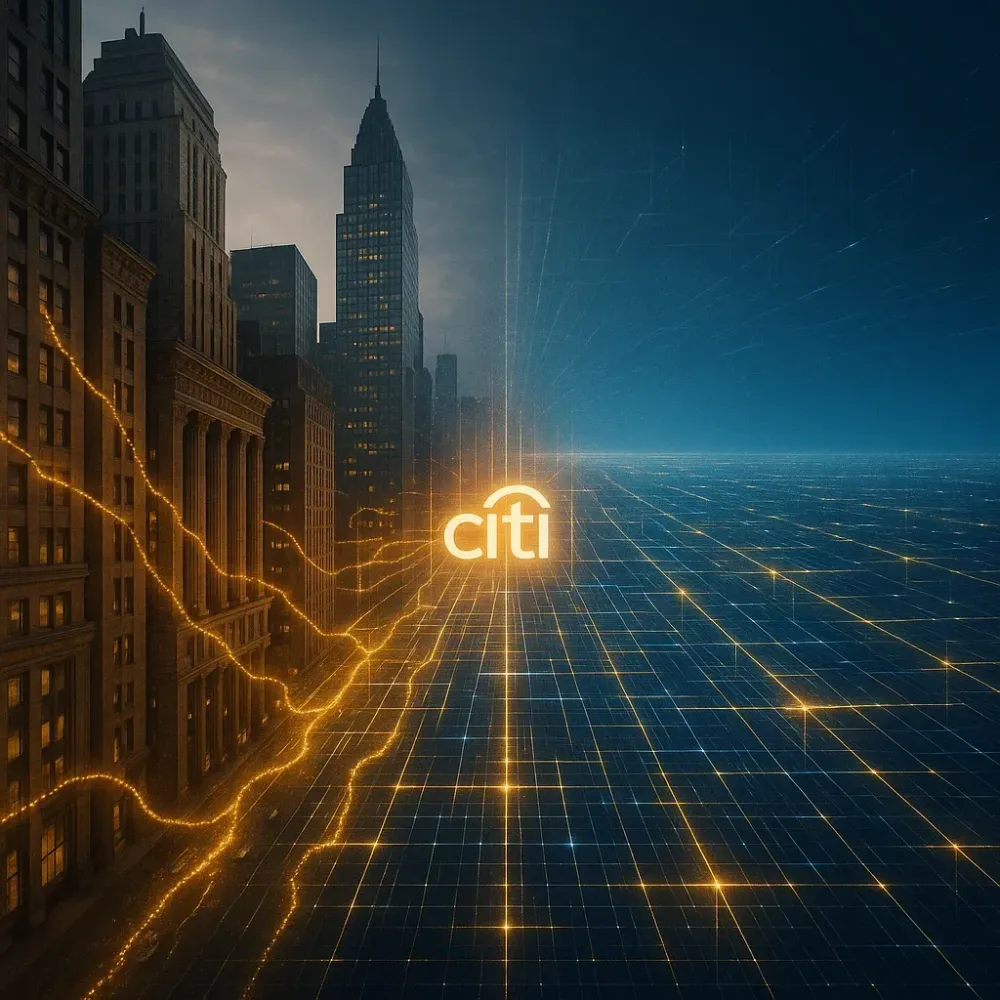Citigroup to Launch Crypto Custody in 2026, Joins G7 Stablecoin Consortium
Citi’s Crypto Custody Countdown — Wall Street’s Next Big On-Chain Play
After years of quiet development, Citigroup is stepping into crypto custody — signaling that Wall Street’s war for digital money is officially underway.
⚡ Quick Hits
- 🏦 Launch target: 2026
- 💰 Scope: Native crypto custody for institutional clients
- 🌍 Built-in integration: In-house + third-party infrastructure
- 💸 Stablecoin partnership: Citi joins 9-bank G7 consortium
- ⚖️ Liquidity concern: Potential $1T deposit flight from traditional banks
🚀 Citi’s Crypto Custody Countdown Begins
After nearly three years of R&D in stealth mode, Citigroup has confirmed plans to launch crypto custody services in 2026, becoming one of the first major Wall Street banks to manage digital assets directly for clients.
According to Biswarup Chatterjee, Citi’s Global Head of Partnerships and Innovation, the service will allow the bank to hold native cryptocurrencies — Bitcoin, Ethereum, and more — for institutional investors and asset managers.
“We’re hoping that in the next few quarters, we can come to market with a credible custody solution,” said Chatterjee.
Behind the scenes, Citi has been building the plumbing — compliant storage, multi-jurisdictional security, and integration with existing clearing systems. The move would finally bridge institutional crypto storage with traditional finance infrastructure at scale.
🧠 Wall Street’s Quiet March Toward Crypto
Citi isn’t alone — it’s just the latest domino to fall.
While JPMorgan lets clients trade digital assets, it hasn’t yet entered custody — though insiders hint at a 2025 rollout.
Citi CEO Jane Fraser made the strategy clear:
“Digital assets are the next evolution in the broader digitization of payments, financing, and liquidity.”
The bank already runs a blockchain-based transfer network connecting New York, London, and Hong Kong, settling transactions 24/7 — a preview of the “always-on” banking model Citi envisions.
And soon, that model will include crypto and tokenized deposits — the backbone of the next-generation financial rails.
🌐 The G7 Stablecoin Project: Banks Strike Back
Citi is also part of the G7 Stablecoin Consortium, alongside Goldman Sachs, Deutsche Bank, Bank of America, Santander, BNP Paribas, MUFG, TD Bank, and UBS.
Their plan: a jointly backed, fiat-pegged digital currency available on public blockchains.
It’s a direct response to the explosive rise of private stablecoins like USDT and USDC — which now move trillions in payments annually.
Regulators are already in early discussions with the consortium. The banks’ pitch? Stability, compliance, and yield — a combination meant to outcompete crypto-native issuers.
Bloomberg Intelligence estimates stablecoins could process $50 trillion in annual payments by 2030, rivaling Visa and SWIFT. In other words: banks want their cut.
⚠️ Deposit Flight: The $1 Trillion Risk
But not everyone’s celebrating.
Standard Chartered warned that if yield-bearing stablecoins become mainstream, emerging-market banks could lose up to $1T in deposits by 2028, as savers chase higher returns in digital assets.
The Bank of England even floated ownership caps — between £10K and £20K per user — to prevent liquidity erosion.
Citi’s own research chief Ronit Ghose called it “a 1980s-style deposit flight,” comparing it to when money market funds lured retail cash away from banks in search of yield.
“Between 1981 and 1982, U.S. banks saw $32 billion more withdrawals than new deposits,” Ghose noted.
Now, regulators fear the same cycle — only on-chain.
🧩 The Lobbying War
Traditional banking groups, including the American Bankers Association and Bank Policy Institute, are pushing Congress to close the “GENIUS Act” loophole that lets crypto firms offer yield-bearing stablecoins.
They warn of potential $6.6 trillion in deposit outflows if stablecoins replace savings accounts as the default yield vehicle.
Crypto leaders, however, call this fearmongering.
Paul Grewal, Chief Legal Officer of Coinbase, dismissed the claims as:
“An unrestrained attempt to avoid competition.”
Coinbase Research even published data showing no significant correlation between stablecoin growth and deposit decline among smaller U.S. banks over the past five years.
🔒 Citi’s Balancing Act
Citi now faces a double challenge: Innovate fast enough to stay relevant — but not so fast that it destabilizes the system it’s part of.
By 2026, its crypto custody division aims to go live, backed by regulatory dialogue, client testing, and $2.57 trillion in existing custody assets.
If successful, Citi could set a new institutional benchmark for tokenized finance — and ignite a wave of 24/7 settlement adoption across Wall Street.
🧠 The Bigger Picture: Who Controls the Money of the Future?
With banks entering custody, stablecoins, and tokenization, the line between TradFi and DeFi is vanishing.
The question isn’t if crypto and banking will merge — it’s who will define the rules.
Will it be the blockchain maximalists, the legacy banks, or a hybrid model where both sides share the rails of a new monetary system?
Citi’s move is more than a product launch — it’s a declaration. Wall Street isn’t resisting crypto anymore. It’s moving in.
TL;DR
- 🏦 Citigroup to launch crypto custody by 2026
- 🌍 Joins G7 Stablecoin Consortium with global banks
- 💸 Stablecoins could process $50T annually by 2030
- ⚠️ Analysts warn of deposit flight from traditional banks
- 💬 Citi sees digital assets as the next evolution of finance
- 🧠 The future of money may belong to both banks and blockchains

Recent News
All Time High • Live
Have questions or want to collaborate? Reach us at: info@ath.live











